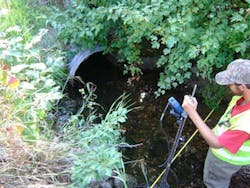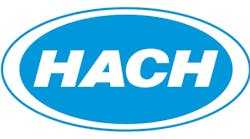Trout Unlimited, a national nonprofit organization founded in 1959, has over 400 chapters, 30 offices and 140,000 members who are dedicated to the mission of conserving, protecting and restoring North America's coldwater fisheries and their watersheds. Its membership remains steadfast in its commitment “to ensure that robust populations of native and wild coldwater fish once again thrive within their North American range, so that our children can enjoy healthy fisheries in their home waters.”
One of its many activities to save the fish for future generations involves the careful monitoring of stream flow around irrigation diversion structures, both upstream and downstream, as well as ditch monitoring.
“We are using flowmeters to collect data from streams and ditches to get an idea of the amount of fish entrainment,” said Justin Thorson, fisheries technician with AmeriCorps. “Typically the more water a ditch diverts, the more likely fish will be entrained.”
Fish entrainment is defined as fish being transported along with the flow of water and out of their normal stream, river, lake or reservoir habitat into unnatural or harmful environments.
“The collected flow data is then used to determine how we prioritize the work of creating diversion structures for fish passage improvement,” said Thorson.
Trout Unlimited purchased a Hach FH950 handheld flowmeter to use in diversion studies that were performed by Thorson and his group located in Missoula, Mont. He had used the Hach FH950’s predecessor—the Marsh-McBirney FLO-MATE—a few times in the past, but indicates he is now exclusively using the FH950.
“The meter has worked out really well for us,” he said. “The best part of using the meter is actually being able to see the amount of flow coming through a cross-section without having to do a ton of math. It’s nice being able to plug in everything and go.”
Thorson was trained on the meter prior to the season. Diversion surveys take approximately 30 minutes to complete, and Thorson is in the field 8 to 9 hours per day from April to mid-October during the busy monitoring season. Typical stream flows are 50 cu. ft per second and approximately 1 to 2 cu. ft per second through the diversions. Most of the sites are accessible and are located in flat valleys.
“It’s not too hard to push your way through them,” said Thorson. “The meter is really lightweight and a lot more compact for field work.”
Using the Hach FH950 has both simplified and sped up the survey work process for Thorson.
“I can’t imagine having to calculate everything by hand, especially now that we can just enter info into the FH950 and it works so well,” he said. “It definitely has reduced the amount of time we had to put into surveys. Before the FH950 we could only do three diversion surveys a day, and now we can get up to five.”
The flow data is easily downloaded via USB.
“We go in and take out the files we need and copy them,” said Thorson. “We keep a log of reference data and use it to prioritize our work to improve fish passage.”



